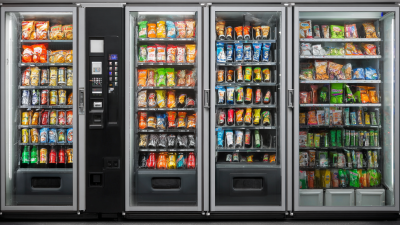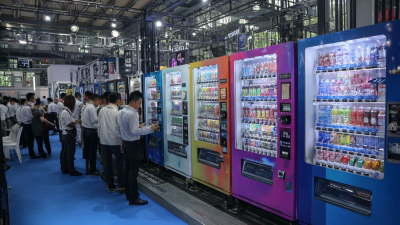Maximizing Vending Locations: Strategies to Boost Sales by 30% in Urban Areas
In the fast-paced urban environment, vending locations are emerging as key players in the retail landscape, with the potential to significantly enhance sales figures. According to a report by IBISWorld, the vending machine industry's revenue is projected to reach $27 billion by 2023, fueled by increasing consumer preference for convenience and on-the-go options. Moreover, a study by Statista indicates that nearly 20% of consumers purchase snacks or beverages from vending machines at least once a week, underscoring the growing acceptance of these automated retail solutions. By strategically selecting and optimizing vending locations within urban settings, operators can capitalize on high foot traffic areas and consumer trends, ultimately aiming to boost sales by up to 30%.

This article explores effective strategies to maximize vending locations and leverage technology to stay ahead of the competition in this rapidly evolving market.
Identifying High-Traffic Vending Locations for Optimal Product Exposure
Identifying high-traffic vending locations is crucial for maximizing sales in urban areas. To achieve optimal product exposure, entrepreneurs should conduct thorough research to pinpoint spots with significant footfall, such as
transportation hubs, shopping districts, and popular recreational areas. Leveraging data analytics and foot traffic insights can aid in selecting sites where potential customers converge, maximizing visibility and accessibility.
Moreover, understanding demographic patterns in urban environments can enhance location selection. Locations frequented by diverse age groups and cultures can allow for tailored product offerings that resonate with the community. Seasonal trends and local events should also be considered, as they can temporarily increase traffic, presenting opportunities for higher sales. By combining strategic location analysis with an awareness of the local context, vending machine operators can effectively boost sales and ensure consistent revenue growth.

Leveraging Data Analytics to Determine Peak Sales Times
To maximize vending locations' sales in urban areas, leveraging data analytics to determine peak sales times is crucial. Utilizing real-time data can help vending operators identify high-traffic periods and locations, enabling them to strategically place their machines. For instance, during the Qingming holiday, certain routes and public spaces experienced congestion, indicating that these areas could see increased foot traffic and potential sales. Understanding such patterns can significantly boost vending sales.
**Tips:**
1. **Analyze Traffic Patterns:** Regularly monitor and analyze local traffic and pedestrian data to identify peak times for specific locations. By adjusting machine stock levels and types of products offered, businesses can cater to the immediate needs of consumers.
2. **Stay Informed About Events:** Keep track of local holidays, events, and potential bottlenecks that increase foot traffic. Positioning machines near these areas can drive sales significantly when the demand is highest.
Through the application of these strategies, vending locations can effectively increase sales by adapting to real-time data and consumer behavior trends.
Maximizing Vending Locations: Strategies to Boost Sales by 30% in Urban Areas - Leveraging Data Analytics to Determine Peak Sales Times
| Location | Peak Sales Time (Hour) | Average Daily Sales ($) | Recommended Products |
|---|---|---|---|
| Downtown Office Building | 12 PM | $150 | Energy Drinks, Snacks |
| University Campus | 3 PM | $200 | Cafes, Water Bottles |
| City Park | 1 PM | $120 | Ice Cream, Soft Drinks |
| Shopping Mall Entrance | 5 PM | $250 | Candy, Chips |
| Train Station Platform | 8 AM | $300 | Coffee, Breakfast Bars |
Enhancing Vending Machine Visibility and Accessibility in Urban Spaces
In urban areas, enhancing the visibility and accessibility of vending machines can significantly boost sales. One effective approach is to strategically position machines in high-traffic locations, such as near public transport stations, parks, and popular shopping districts. This increases footfall and ensures that potential customers encounter vending options more frequently. Moreover, clear signage and attractive designs can grab attention and draw in passersby.
Tips: Consider using social media platforms to announce new vending locations and promote special offers. Engaging with local communities can also help in identifying ideal spots and tailoring product selections to meet the preferences of diverse urban populations.
Additionally, vending machines that cater to specific needs, such as menstrual hygiene products, are increasingly important in addressing access issues for marginalized groups. These machines not only provide essential items but also promote dignity and convenience. By prioritizing such products in urban vending strategies, operators can create a more inclusive environment while driving sales.
Tips: Monitor community feedback to understand the demand for different products and adjust offerings accordingly. This responsiveness can enhance customer satisfaction and encourage repeat usage.

Utilizing Local Partnerships to Expand Vending Product Offerings
Local partnerships are essential in maximizing vending locations and enhancing product offerings, especially in urban areas where competition is fierce. By collaborating with local businesses, vending operators can tap into unique, region-specific products that cater to the tastes and preferences of community members. According to a report from IBISWorld, the vending machine industry in the U.S. has grown at an annual rate of 1.9% to reach $7 billion in revenue by 2023. This growth underscores the importance of diversifying offerings to attract local consumers, who often seek options that resonate with their local culture.
Furthermore, leveraging local partnerships can also improve brand visibility and customer loyalty. A study by Nielsen indicates that 66% of consumers are willing to pay more for products from brands that are committed to positive social and environmental impact. By sourcing snacks and beverages from nearby suppliers, vending businesses not only enhance their product variety but also position themselves as community supporters. This strategy fosters customer trust and engagement, driving sales growth. Effective partnerships can lead to a projected 30% increase in sales as consumers are more likely to support vending options that reflect their community and values.
Implementing Dynamic Pricing Strategies to Maximize Revenue Potential
Dynamic pricing strategies are proving to be a game-changer in the urban vending machine market, with reports indicating that businesses can boost their revenue potential by as much as 30%. This strategy involves adjusting the prices of vending machine products based on real-time demand, location, and even time of day, allowing operators to maximize profits and respond effectively to market fluctuations.
According to a study by the National Automatic Merchandising Association (NAMA), vending machines that adopted dynamic pricing saw a 15% increase in sales within the first quarter of implementation.
Furthermore, utilizing data analytics is crucial in formulating effective dynamic pricing strategies. By analyzing purchasing patterns and customer behavior, vending operators can determine optimal price points and identify high-traffic locations that may warrant premium pricing. The International Journal of Business and Management reports that incorporating AI-driven analytics can lead to a revenue increase of up to 25%, providing a significant competitive edge in saturated urban environments.
As urban areas continue to grow, vending machine operators must embrace these innovative pricing methods to capture a larger market share and enhance profitability.
Related Posts
-

5 Essential Tips for Finding the Best Vending Machine Locations Worldwide
-

10 Best IT Vending Machines Transforming Workspaces in 2023
-

Ultimate Guide to Maximizing Profits with Snack and Drink Vending Machines
-

7 Smart Tips for Optimizing Your Snack and Drink Vending Machine Business
-

Exploring Vending Machines Market Trends at the 138th China Import and Export Fair 2025
-

The Future of Coffee Vending Machines Embracing Card Readers for a Seamless Experience
